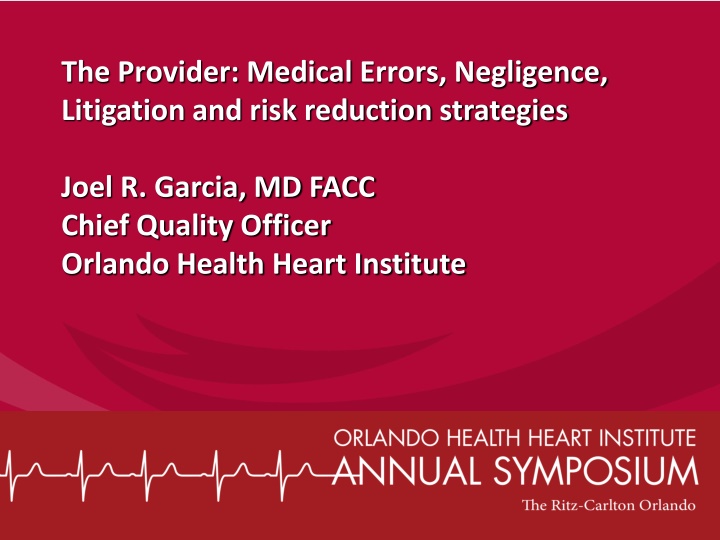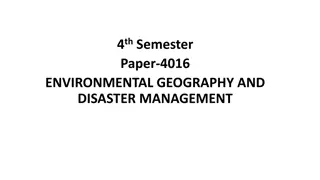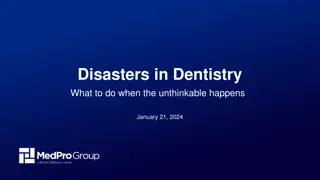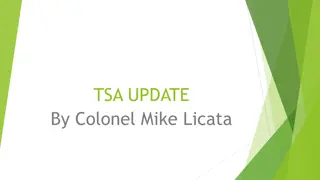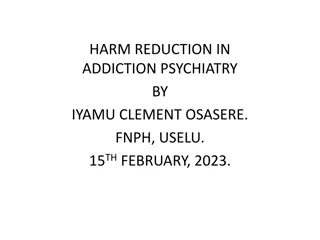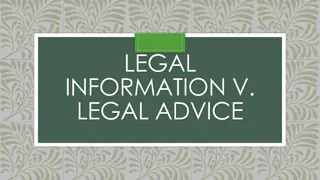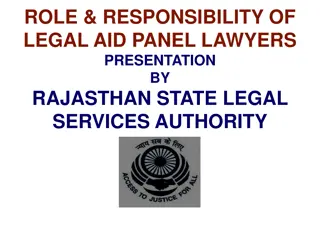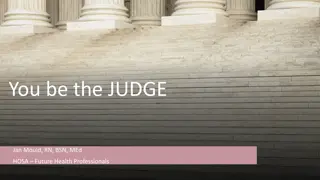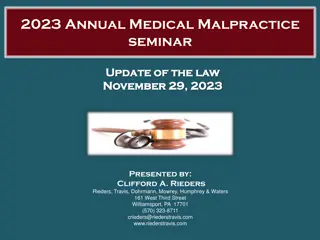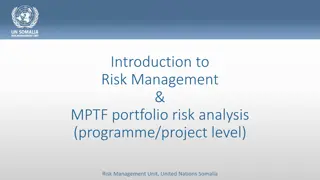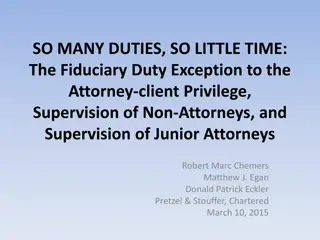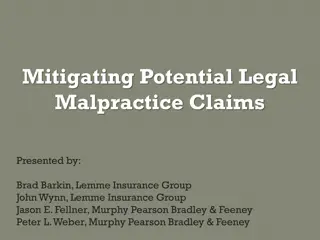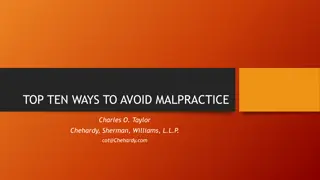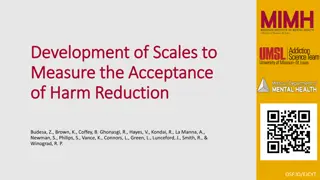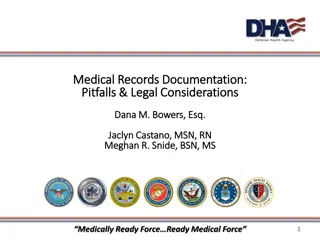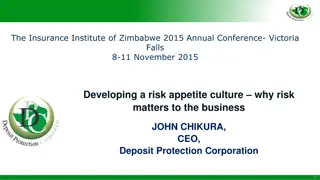Medical Malpractice: Risk Reduction Strategies & Legal Elements
Explore key aspects of medical malpractice, including negligence, duty of care, breach of duty, causation, and injury. Learn how to establish the need for knowledge to prevent errors, reduce risks, and navigate litigation. Discover ways to uphold the standard of care, consider legal responsibilities, and mitigate liabilities in healthcare practice.
Uploaded on Jul 31, 2024 | 1 Views
Download Presentation

Please find below an Image/Link to download the presentation.
The content on the website is provided AS IS for your information and personal use only. It may not be sold, licensed, or shared on other websites without obtaining consent from the author.If you encounter any issues during the download, it is possible that the publisher has removed the file from their server.
You are allowed to download the files provided on this website for personal or commercial use, subject to the condition that they are used lawfully. All files are the property of their respective owners.
The content on the website is provided AS IS for your information and personal use only. It may not be sold, licensed, or shared on other websites without obtaining consent from the author.
E N D
Presentation Transcript
The Provider: Medical Errors, Negligence, Litigation and risk reduction strategies Joel R. Garcia, MD FACC Chief Quality Officer Orlando Health Heart Institute
Disclaimer This lecture does not, in any way, constitute legal advice or the practice of law and is not intended to replace legal counsel. 2
Establishing the Need to Know Knowledge is empowering Move from fear- victim mode -to- proactive- preventive mode 3
Anatomy of a Medical Malpractice Cause of Action A form of negligence Liability exists whether actions were intentional or unintentional Negligence results when the provider s conduct falls below the standard of care established to protect the patient from an unreasonable risk of harm 4
Four Elements We Need to Know 1. Duty 2. Breach of Duty 3. Actual and proximate causation 4. Injury 5
DUTY To provide a standard of care, that other reasonably prudent providers (MD s, NP s., PA s) in the same set of circumstances, would provide 6
DUTY Standard of Care Considerations Medical Act of your State Board of Medicine defining your scope of practice National treatment guidelines Institutional treatment protocol/guidelines Expert testimony 7
BREACH OF DUTY A deviation from the standard of care An expert witness may be deposed As a board certified provider (MD), national standards will be used, in part, as the benchmark of the acceptable standard of care 8
ACTUAL AND PROXIMATE CAUSATION The analysis of the actual causation element involves the but for test But for the provider s action, injury would not have occurred Foreseeability the injuries were the result of the provider's action and the injuries were foreseeable before the injury occurred 9
ACTUAL AND PROXIMATE CAUSATION A patient came to a medical office for a H+P. A NP took the history and noted that there was a remote history of ulcer with no recent complaints. The patient came back later complaining of back pain. A physician read the NP s history and initiated aspirin therapy. The patient developed a GI bleed. The patient sued the NP for failing to diagnose an ulcer and sued the physician for failing to order an endoscopy before starting the patient on aspirin. The court found for the NP and the physician. The court found that the patient had failed to prove a connection between the patient s GI bleed and failure to diagnose the ulcer in order to order an endoscopy earlier. The plaintiff failed to prove actual and proximate causation. 10
HARM Injury must be proven By presentation of: Medical bills Expert testimony Direct evidence of pain and suffering 11
Systematic Approach to Primary Prevention of Malpractice Incorporate a review of the elements of medical malpractice into each encounter Reflexive process of thinking 12
Medical Errors, Negligence, and Litigation I. II. III. IV. Medical Errors Relationship of Medical Errors to Negligence Why do People Sue their Doctors? Potential Solutions to the Problem of Medical Errors
Definitions Error Failure of a planned action to be completed as intended (i.e., error of execution) or the use of a wrong plan to achieve an aim (i.e. error of planning) Adverse Event (AE) An injury caused by medical management rather than the underlying condition of the patient Preventable Adverse Event An adverse event attributable to an error
Relationship of Medical Errors to Adverse Events Preventable AEs Medical Errors Accidental errors
Epidemiology of Medical Errors California Medical Insurance Feasibility Study (1974) 20,864 hospital admissions 4.65 injuries per 100 hospitalizations Harvard Medical Practice Study (1984) 30,121 hospital admissions in NY state Reported adverse events (AE s) 3.7% of admissions had an AE
Quality in Australian Health Care Study Reviewed 14,179 admissions in 1995 16.6% of admissions had an AE s Permanent disability 13.7% Death 4.9% 51% of events preventable Source Wilson, 1995
To Err is Human IOM releases report To Err is Human (2000) Estimates 44,000 to 98,000 unnecessary deaths each year due to medical error Estimated 1,000,000 excess injuries due to medical error Numbers based on the MPS and extrapolated to the general population
Deaths due to Medical Error 44,000 to 98,000 unnecessary deaths each year More Americans are killed in US hospitals every 6 months than died in the entire Vietnam War Death rate equivalent to three jumbo jet crashed every two days
Where do these numbers come from and why might they be overestimated Methods Physician implicit judgment Causality of death difficult Kappa statistics low Overcoming these shortcomings Utilizing more reviewers Requiring greater agreement Requiring assessment of overall prognosis
Views of the Public on Medical Errors Percentage of adults experiencing an error Medication or medical error 22% Mistake at the physician s office or hospital 10% Wrong medication or dose 16% Source- The Commonwealth Fund, 2001
Views of Practicing Physicians and the Public on Medical Errors Response Physicians (N = 831) Public (N = 1207) P Value All Respondents percent 35 42 <0.001 Error made in own or family member s care Health consequences: (Serious) 18 24 <0.001 Respondents reporting an error 70 81 <0.001 Parties who had a lot of responsibility for the error: (Doctors) Health professional told respondent an error had been made 31 30 <0.001 Possible solutions to the problem of medical errors Increasing lawsuits for malpractice 1 23 <0.001 Hospital reports of serious medical errors should be: Confidential 86 34 <0.001 Made public 14 62 <0.001 Source- Blendon, 2002
Disposition of Claims According to the Rating of the Plaintiff's Injury and Degree of Disability Rating No. of Closed Cases Settled for Plaintiff Mean Settlement $ no (%) Type of injury No adverse event 24 10 (42) 28,760 Adverse event 13 6 (46) 98,192 Negligent adverse event 9 5 (56) 66,944 Disability None 24 10 (42) 28,760 Temporary 14 4 (29) 38,857 Permanent 8 7 (88) 201,250 All claims 46 21 (46) 55,853 Source Brennan, 1996
1000 All Injuries All Negligent Injuries 280 Files a Claim 36 13% of Negligent Injuries Results in a Claim
Negligent Medical Injuries All Hospitalizations Negligent Injuries (1-2%) Sources- Mills et al. (1977), Brennan et al. (1991), IOM (1999).
Negligent Injuries that Did Not Result in a Claim 27,179 adverse events due to negligence 26,764 with no malpractice claim (98%) 415 malpractice claims (2%) 14,180 with strong evidence of negligence 12,858 with disability 7462 with disability < 6 mo (58%) 5396 with disability 6 mo (42%) Source Localio, 1991
Medical Errors 42% of public report a medical error 66% reported serious consequences such as severe pain, substantial loss of time at work or school, disability or even death Only 6% had sued
Why is medicine so susceptible? Lack of awareness to the problem Culture of Silence Blame and shame mentality System constraints Staffing problems Fatigue Knowledge requirements Communication and continuity of care
The State of Medical Malpractice Medical-malpractice litigation infrequently compensates patients injured by medical negligence and rarely identifies, and holds providers accountable for, substandard care Source Localio, 1991
Medical Errors, Negligence, and Litigation I. II. III. IV. Medical Errors Relationship of Medical Errors to Negligence Why do People Sue their Doctors? Potential Solutions to the Problem of Medical Errors
Reasons Why People Sue Their Doctors Percent Expressing Concern Advised to sue by influential other Needed money Believed there was a cover-up Child would have no future Needed information Wanted revenge, license 32 24 24 23 20 19 Source - Hickson, 1992
Malpractice Risk Malpractice activity is disproportionate among physicians 75% - 85% of awards, settlement costs over a 5- year period made on behalf of 1.8% of internists 6.0% of obstetricians 8.0% of surgeons Source- Sloan, 1989, Bovbjerg, 1994
Malpractice Activity and Patient Complaints Physician Characteristic Total Physicians (N = 645) Surgeons (N = 219) Mean Number of Complaints No lawsuits (N = 102) 6.1 1 lawsuit (N = 82) 16.7 2 or more lawsuits (N = 35) 35.1 Non-surgeons (N = 426) No lawsuits (N = 361) 4.7 1 lawsuit (N = 57) 9.2 2 or more lawsuits (N = 8) 4.6 Source Hickson, 2002
Nine Percent of Physicians Account for Fifty Percent of the Complaints % of Complaints 100 90 80 70 60 50 40 30 20 10 0 30 40 50 60 70 80 90 100 % of Physicians Source Hickson, 2002
Communication and Malpractice Claims Primary Care Physicians (n = 59) Variable No Claims (n = 29) Claims (n = 30) P- Value Visit length, min 18.3 15.0 < 0.05 No. of utterances per 15-min visit: Content Asks questions- medical 18.3 16.9 NS Gives information medical 28.5 26.3 NS Process: Facilitation (Physician) 19.4 11.9 < 0.05 Orientation (Physician) 14.5 11.2 < 0.05 Affect Laughs (Physician) 4.8 3.4 < 0.05 Laughs (Patients) 7.8 7.5 NS Source Levinson, 1997
Communication and Malpractice Claims Prior Malpractice Claims Group Category of complaint, % No Claims High Frequency P - value Physician-patient communication 8.2 27.6 0.01 Would not talk 6.7 23.5 0.01 Did not listen 1.9 7.1 0.01 Humanity of a physician 4.8 17.4 0.01 Yelled 4.8 9.2 0.15 No concern for me as a person 1.4 8.7 0.01 Source Hickson, 1994
Medical Errors, Negligence, and Litigation I. II. III. IV. Medical Errors Relationship of Medical Errors to Negligence Why do People Sue their Doctors? Potential Solutions to the Problem of Medical Errors
Malpractice as a Barrier to Safety Physicians overestimate the risk of being sued Less likely to report errors as a result
Other Potential Solutions Learn lessons from other industries Aviation, Military, Nuclear Power Development of IT infrastructures POE, Communication Less reliance on memory Restriction on working hours AAMC proposed guidelines (80 hour week) Greater staffing to patient ratios Improved nursing jobs Organizational Culture
Physicians and nurses need to accept the notion that error is an inevitable accompaniment of the human condition, even among conscientious professionals with high standards. Errors must be accepted as evidence of system flaws not character flaws. Leape, 1994
Common Sense Risk Reduction Strategies
Hot Spots for Negligence (Rule Out The Worst Diagnosis Early ) Example: 1. Middle-aged man experienced chest pain at work 2. NP evaluated and conferred with physician 3. Providers diagnosed muscle spasm and gave Valium Rx 4. Went to ER was given codeine 5. The next day went to the ER and after EKG performed, was diagnosed with MI 6. Plaintiff sued for lost wages and won against Providers 45
CONSIDERATIONS Follow established national guidelines as well as the policy and procedures of the organization in which you are practicing Remember the phrase, Ordinary reasonable care Would a reasonable practitioner in your situation make the same decisions? 46
COMMUNICATION CONSIDERATIONS Electronic communications are discoverable (E-Mail, etc.) May be used to demonstrate admission of an error May be used to demonstrate a pattern of mistakes that have been admitted 47
Risk Management Strategies A Thorough Timely Medical Record The Witness Whose Memory Never Fades
Defense Strategy Comparative Negligence Modified Comparative Fault 50% rule: An injured party can only recover if it is determined that his or her fault is 49% or less. Thus, no recovery if the Plaintiff is 50% or more at fault (Arkansas, Colorado, Georgia, Idaho, Kansas, Maine, Nebraska, North Dakota, Oklahoma, Tennessee, Utah, and West Virginia) 49
Defense Strategy Comparative Negligence Modified Comparative fault 51% rule: The injured party must be 50% or less at fault to recover damages. Thus no recovery if the Plaintiff is 51% or greater, at fault Ohio and Pennsylvania follows this rule of law How might you incorporate this rule of law in your daily clinical practice as a defensive strategy? 50
